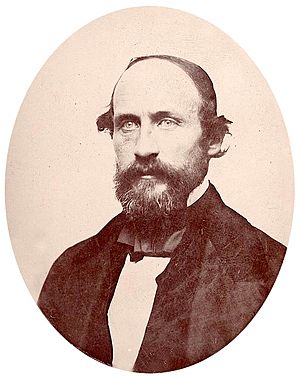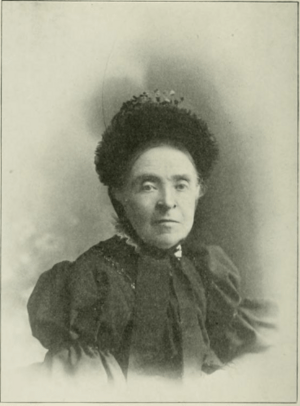Charles L. Robinson facts for kids
Quick facts for kids
Charles Robinson
|
|
|---|---|
 |
|
| 1st Governor of Kansas | |
| In office February 9, 1861 – January 12, 1863 |
|
| Lieutenant | Joseph Pomeroy Root |
| Preceded by | Samuel Medary (Kansas Territory) |
| Succeeded by | Thomas Carney |
| Member of the Kansas Senate | |
| In office 1873–1881 |
|
| Member of the California Assembly from the 12th district |
|
| In office 1851–1852 |
|
| Personal details | |
| Born | July 21, 1818 Hardwick, Massachusetts, U.S. |
| Died | August 17, 1894 (aged 76) Lawrence, Kansas, U.S. |
| Political party | Whig (before 1852) Republican (1852–1890) Republican (1890–1894) |
| Spouses | Sarah Adams Sara Lawrence |
| Education | Amherst College (BS) Berkshire Medical College (MD) |
| Signature | |
Charles Lawrence Robinson (July 21, 1818 – August 17, 1894) was an important American politician. He served in the California State Assembly from 1851 to 1852. Later, he became the first Governor of Kansas from 1861 to 1863.
Robinson was also the first governor of a U.S. state to be impeached by a state legislature. However, he was found not guilty during his impeachment trial and stayed in office. After being governor, he served in the Kansas Senate from 1873 to 1881. He is still the only Kansas governor to be impeached but not removed from office.
Contents
Early Life and Education
Growing Up in Massachusetts
Charles Robinson grew up in Massachusetts. He went to Hadley and Amherst academies. He also attended Amherst College.
He decided to study medicine. He learned in Woodstock, Vermont, and later in Pittsfield, Massachusetts. In 1843, he earned his medical degree from the Berkshire Medical College. After finishing school, he worked as a doctor in several towns in Massachusetts. These included Belchertown, Springfield, and Fitchburg.
Adventures in California
Moving West
In 1849, Charles Robinson traveled all the way to California. This was during the exciting time of the Gold Rush. In 1850, he worked as an editor for a newspaper in Sacramento. It was called the Settler's and Miner's Tribune.
He became involved in local events. He supported the rights of settlers to claim land. During this time, he faced some legal challenges. Even so, he was elected to the California legislature. He represented California's 12th State Assembly district from 1851 to 1852. The court later cleared him without a trial.
Family Life
In 1851, Charles married Sara Tappen Doolittle Lawrence. They had two children together. Sara later wrote a book about the fight over slavery in Kansas. It was called Kansas, its Exterior and Interior Life. In 1852, Charles went back to Massachusetts. There, he ran a weekly newspaper called the News in Fitchburg.
Life in Kansas
Fighting for Freedom
In 1854, Robinson heard Eli Thayer speak. Thayer was from the New England Emigrant Aid Company. He talked about the need to stop slavery from spreading. Robinson was inspired and agreed to help the company.
He became their financial agent. In June 1854, Robinson went to Kansas Territory. He looked for land where the company could start a town. This town would support the idea of a "free state." This means a state where slavery was not allowed. His efforts led to the founding of Lawrence.
Bleeding Kansas
Kansas was a very difficult place during this time. It was known as the "Bleeding Kansas" period. People who supported slavery fought against those who wanted Kansas to be free. Robinson strongly supported the Free-Staters.
In January 1856, he was chosen as the Territorial Governor of Kansas. This election was not officially recognized. From spring to September 1856, Robinson and other Free-State leaders were held in a military camp. This camp was near Lecompton, Kansas.
Governor of Kansas
Taking Office
In 1861, Kansas officially became a state. Charles Robinson became its first governor. He served one term, from February 9, 1861, to January 12, 1863.
Impeachment Trial
In 1861, the Kansas House of Representatives accused Governor Robinson of wrongdoing. They also accused Secretary of State J. W. Robinson and State Auditor George S. Hillyer. The accusation was about how they handled money for raising troops. These troops were for the Union side during the American Civil War.
Governor Robinson had an impeachment trial in the State Senate. He was found not guilty. This meant he could stay in office. However, the trial did affect his political future. The other two officials were found guilty and removed. This impeachment was partly due to a political disagreement. It was between Robinson and James H. Lane, who was a U.S. Senator from Kansas.
Later Years
Continuing Public Service
After his time as governor, Robinson continued to serve the public. He was elected to the Kansas State Senate. He served there from 1873 to 1881. He also led the Kansas Historical Society from 1879 to 1880.
Later, he became a Superintendent at the Haskell Institute. He worked there from 1887 to 1889. He also served as a regent for the University of Kansas for twelve years.
Charles Robinson passed away on August 17, 1894. He was buried in Oak Hill Cemetery in Lawrence, Kansas.



